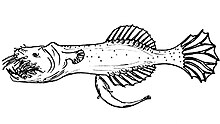| Toothed seadevil | |
|---|---|

| |
| Conservation status | |
 Least Concern (IUCN 3.1) | |
| Scientific classification | |
| Domain: | Eukaryota |
| Kingdom: | Animalia |
| Phylum: | Chordata |
| Class: | Actinopterygii |
| Order: | Lophiiformes |
| Suborder: | Ceratioidei |
| Family: | Neoceratidae Regan, 1926 |
| Genus: | Neoceratias Pappenheim, 1914 |
| Species: | N. spinifer |
| Binomial name | |
| Neoceratias spinifer Pappenheim, 1914 | |
The toothed seadevil, spiny seadevil or netbeard seadevil, (Neoceratias spinifer), is a rarely seen deep-sea anglerfish found in the mesopelagic and bathypelagic zones in Oceans around the World. It is the only species in the family Neoceratidae, and is unique amongst the deep-sea anglerfish in lacking an illicium and esca (the "fishing rod" and "lure"), and in having large teeth placed on the outside of its jaws.
Taxonomy
The toothed seadevil was first formally described in 1914 by the German zoologist Paul Pappenheim with the type locality given as the South Atlantic around 416 km (258 mi) north of Saint Helena at 12°11'S, 6°16'W from a depth between 0 and 2,000 m (0 and 6,562 ft). When Pappenheim described this species he classified it in the new monospecific genus Neoceratias. In 1926 Charles Tate Regan created the monotypic family Neoceratiidae for this taxon. The 5th edition of Fishes of the World classifies the family Neoceratiidae in the suborder Ceratioidei of the anglerfish order Lophiiformes.
Etymology
The toothed seadevil has the genus name Neoceratias, which prefixes Ceratias, a genus of anglerfishes, with neo, meaning "new". Pappenheim was not sure what the systematic position of the new species was but he thought that it might be close to Ceratias. The specific name spinifer means "spine bearing", this is an allusion to the long needle-like teeth with hinges located on the jaws external to the mouth.
Description
Toothed seadevils are sexually dimorphic. The adult females have slender, elongate bodies up to 11 centimetres (4.3 in) long. They are dark red-brown to black in color, with naked skin. The mouth is large and extends well past the small eye; the jaws have an inner row of short, straight, widely spaced, immobile teeth. On the outside of the jaws, there are prominent conical outgrowths that bear 2-3 straight teeth, the longest of which reach almost 15% the length of the entire body. Each of these teeth is hinged at the base, with well-developed musculature and a tiny hook at the end. The illicium, or lure, is absent, along with the trough in which it rests in other deep-sea anglerfishes. There are a pair of prominent nasal papillae on the snout; nostrils and olfactory lamellae are absent.
Both the males and larvae differ from other deep-sea anglerfish in having slender bodies. Mature males are only known from parasitic specimens already attached to the females. The largest known specimen is 18 mm long. They are lighter in color than the females and have semitranslucent skin. They are attached to the females by outgrowths of the snout and lower jaw; the olfactory organs are absent and the eyes are degenerate and covered with skin. The larvae are 4–10 mm long, with well-developed olfactory organs and no sexual dimorphism.
Distribution and habitat
The toothed seadevil is found throughout the World. In the Atlantic Ocean it is distributed from off New England south and east to Saint Helena. In the Indian Ocean it has been recorded off far northern Madagascar and in the Bay of Bengal. In the Pacific Ocean it has a wide range extending from the Philippines as far east as Hawaii with a record from as far east as 32°N, 133°E. This species is a deep water fish that has not been collected from depths of less than 1,000 m (3,300 ft).
Biology
The toothed seadevil has no bioluminescent lure and an unusual tooth arrangement, it is unclear what the toothed seadevil feeds upon and how. It has been suggested that their external jaw teeth serve to entangle soft-bodied invertebrates. The males are fully parasitic, using tooth-bearing denticles at the tips of their jaws to attach to the female and their tissues and blood vessels becoming fused with that of the female.
References
- Knudsen, S. (2015). "Neoceratias spinifer". IUCN Red List of Threatened Species. 2015: e.T60481914A60794995. doi:10.2305/IUCN.UK.2015-4.RLTS.T60481914A60794995.en. Retrieved 25 June 2024.
- Froese, Rainer; Pauly, Daniel (eds.). "Neoceratias spinifer". FishBase. October 2008 version.
- ^ Pietsch, Theodore W. (2005). Neoceratias spinifer. Needlebeard Seadevils. Version 6 November 2005 (under construction). Tree of Life Web Project.
- Eschmeyer, William N.; Fricke, Ron & van der Laan, Richard (eds.). "Species in the genus Neoceratias". Catalog of Fishes. California Academy of Sciences. Retrieved 25 June 2024.
- Eschmeyer, William N.; Fricke, Ron & van der Laan, Richard (eds.). "Genera in the family Neoceratias". Catalog of Fishes. California Academy of Sciences. Retrieved 25 June 2024.
- Richard van der Laan; William N. Eschmeyer & Ronald Fricke (2014). "Family-group names of recent fishes". Zootaxa. 3882 (2): 1–230. doi:10.11646/zootaxa.3882.1.1. PMID 25543675.
- Nelson, J.S.; Grande, T.C.; Wilson, M.V.H. (2016). Fishes of the World (5th ed.). Hoboken, NJ: John Wiley & Sons. pp. 508–518. doi:10.1002/9781119174844. ISBN 978-1-118-34233-6. LCCN 2015037522. OCLC 951899884. OL 25909650M.
- Christopher Scharpf (3 June 2024). "Order LOPHIIFORMES (part 2): Families CAULOPHRYNIDAE, NEOCERATIIDAE, MELANOCETIDAE, HIMANTOLOPHIDAE, DICERATIIDAE, ONEIRODIDAE, THAUMATICHTHYIDAE, CENTROPHRYNIDAE, CERATIIDAE, GIGANTACTINIDAE and LINOPHRYNIDAE". The ETYFish Project Fish Name Etymology Database. Christopher Scharpf. Retrieved 25 June 2024.
- Theodore W. Pietsch Ph.D. (2009). Oceanic Anglerfishes: Extraordinary Diversity in the Deep Sea. University of California Press. pp. 450–452. ISBN 978-0520942554.
- Pietsch, Theodore W. "Lophiiformes: Neoceratidae" (PDF). Retrieved 10 October 2008.
| Taxon identifiers | |
|---|---|
| Neoceratias spinifer | |